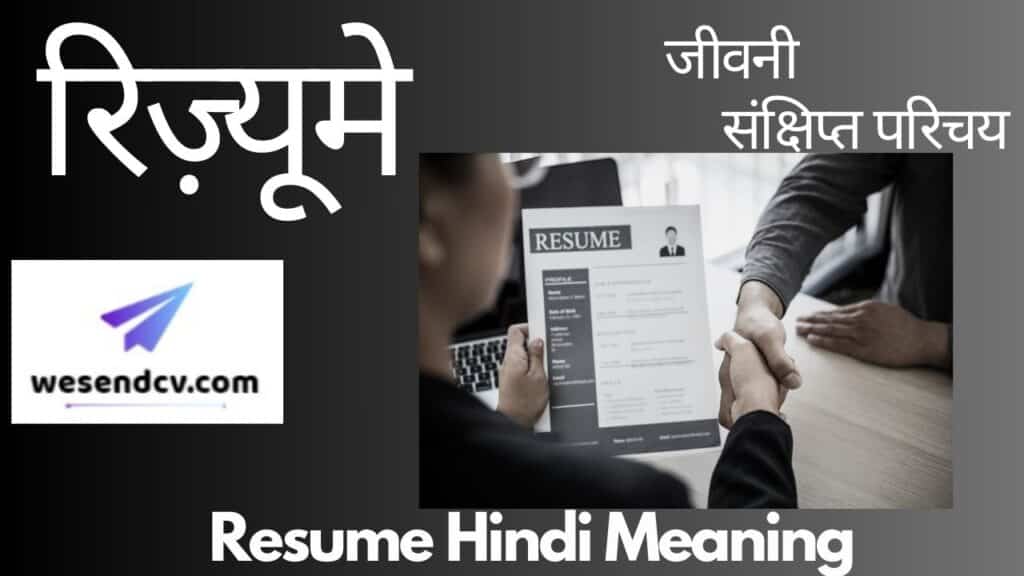The term resume is widely used in professional and job-seeking environments, but its meaning and importance may not always be clear to everyone. In Hindi, a resume is often referred to as “जीवनी” (Jeevani), “संक्षिप्त परिचय” (Sankshipt Parichay), or “रिज़्यूमे” (Resume transliteration). It is a formal document that summarizes a person’s educational qualifications, work experience, skills, and achievements, which are essential for applying to jobs, internships, or higher education programs.
A well-structured resume serves as the first impression for employers and recruiters, highlighting why a candidate is suitable for a particular role. In this article, we will explore:
- The Hindi meaning of a resume and its significance.
- Different types of resumes and their structures.
- The key elements that make a resume effective.
- The difference between a resume, CV, and bio-data in Hindi.
- How to write a resume in Hindi with examples.
- The best resume writing tips for job seekers.
Main Highlights of Content
ToggleWhat is the Hindi Meaning of Resume?
In Hindi, the word resume can have multiple translations depending on the context:
| English Term | Hindi Meaning |
|---|---|
| Resume | रिज़्यूमे / संक्षिप्त परिचय (Sankshipt Parichay) |
| Curriculum Vitae (CV) | जीवन वृत्त (Jeevan Vritt) |
| Bio-Data | व्यक्तिगत विवरण (Vyaktigat Vivaran) |
A resume is a short and precise document that highlights an individual’s qualifications, experience, and skills in a concise format. It is mainly used for job applications and is one or two pages long.
Difference Between Resume, CV, and Bio-Data in Hindi
Many people confuse a resume, CV, and bio-data, but they serve different purposes. Below is a detailed comparison in Hindi:
| Aspect | Resume (रिज़्यूमे) | CV (सीवी / जीवन वृत्त) | Bio-Data (बायोडाटा / व्यक्तिगत विवरण) |
|---|---|---|---|
| Meaning | संक्षिप्त विवरण (Brief summary) | विस्तृत विवरण (Detailed career history) | व्यक्तिगत जानकारी केंद्रित दस्तावेज़ (Personal details-focused document) |
| Length | 1-2 पृष्ठ (Short, 1-2 pages) | 2-3+ पृष्ठ (Longer, 2+ pages) | 1-3 पृष्ठ (Varies, often longer) |
| Focus | कौशल, अनुभव, और शिक्षा (Skills, experience, education) | शोध, प्रकाशन, और अनुभव (Research, publications, detailed career history) | व्यक्तिगत जानकारी, जन्मतिथि, परिवार की जानकारी (Personal details like birth date, family background) |
| Usage | नौकरी आवेदन, कॉर्पोरेट क्षेत्र (For job applications in corporate sectors) | शिक्षा, शोध, वैज्ञानिक क्षेत्र (For academic, research, and scientific fields) | सरकारी नौकरियों, विवाह (For government jobs, marriage, and traditional documentation) |
For private-sector jobs, a resume is preferred. For academic and research-based careers, a CV is used, while bio-data is common in government jobs and personal matters like marriage proposals.
Types of Resumes in Hindi
There are different resume formats based on a candidate’s career stage and job preferences:
1. Chronological Resume (कालानुक्रमिक रिज़्यूमे)
- Lists work experience in reverse chronological order (latest job first).
- Best for candidates with a strong work history.
- Example: Experience in IT, Marketing, Sales, Finance.
2. Functional Resume (कार्यात्मक रिज़्यूमे)
- Focuses on skills rather than experience.
- Suitable for freshers, career changers, or those with employment gaps.
- Example: Skills-based roles like Graphic Designing, Digital Marketing.
3. Combination Resume (संयोजन रिज़्यूमे)
- Mix of chronological and functional resume styles.
- Best for candidates with both experience and strong skills.
4. Targeted Resume (लक्षित रिज़्यूमे)
- Customized for a specific job role.
- Requires adjusting resume content based on job descriptions.
Key Components of a Resume in Hindi
A resume should include the following essential elements:
- नाम और संपर्क जानकारी (Name & Contact Details)
- पूरा नाम (Full Name)
- मोबाइल नंबर (Phone Number)
- ईमेल पता (Email Address)
- लिंक्डइन प्रोफाइल (LinkedIn Profile, if applicable)
- व्यक्तिगत सारांश (Professional Summary)
- 2-3 वाक्य में प्रोफ़ाइल का संक्षिप्त परिचय (Short introduction about experience and skills).
- शिक्षा योग्यता (Educational Qualifications)
- डिग्री, कॉलेज / विश्वविद्यालय, वर्ष (Degree, College/University, Year).
- कार्य अनुभव (Work Experience)
- कंपनी का नाम, भूमिका, कार्यकाल (Company Name, Role, Duration).
- प्रमुख ज़िम्मेदारियाँ (Key Responsibilities).
- कौशल (Skills)
- तकनीकी कौशल (Technical Skills).
- सॉफ्ट स्किल्स (Soft Skills).
- प्रमाण पत्र (Certifications)
- ऑनलाइन या ऑफलाइन कोर्स प्रमाणपत्र (Relevant online/offline certifications).
- भाषा कौशल (Languages Known)
- हिंदी, अंग्रेजी और अन्य भाषाएँ (Hindi, English, or any other known languages).
- अन्य अनुभाग (Additional Sections, if required)
- पुरस्कार और उपलब्धियां (Awards & Achievements).
- रुचियां और शौक (Hobbies & Interests).
How to Write a Resume in Hindi? (हिंदी में रिज़्यूमे कैसे लिखें?)
Step 1: Choose the Right Format
- For freshers → Functional Resume.
- For experienced professionals → Chronological Resume.
- For career changers → Combination Resume.
Step 2: Keep It Concise
- Use bullet points instead of paragraphs.
- Limit the resume to one or two pages.
Step 3: Customize for the Job Role
- Modify skills and experience based on job descriptions.
- Highlight achievements with numbers (e.g., “सेल्स 20% बढ़ाया” – Increased sales by 20%).
Step 4: Use a Professional Design
- Use simple fonts (Arial, Times New Roman, or Calibri).
- Maintain consistent formatting.
Common Mistakes to Avoid in a Resume
- अत्यधिक व्यक्तिगत जानकारी देना (Giving Too Much Personal Information).
- लंबे पैराग्राफ लिखना (Writing Long Paragraphs Instead of Bullet Points).
- असंगठित प्रारूप (Using an Unstructured Format).
- गलत वर्तनी और व्याकरण (Spelling and Grammar Mistakes).
- झूठी जानकारी देना (Providing False Information).
Conclusion
A resume (रिज़्यूमे) is a critical document that represents a candidate’s skills, experience, and qualifications in a structured manner. It is an essential tool for job seekers to stand out from the competition and secure employment.
Understanding the Hindi meaning of a resume, ATS resume checker free online and its different formats helps individuals tailor their resumes to suit their career goals. By avoiding common mistakes and following best practices, candidates can create a professional resume that improves their chances of success in the job market.







